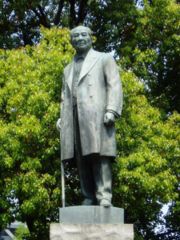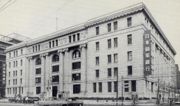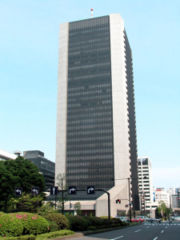第一勸業銀行
出自 MBA智库百科(https://wiki.mbalib.com/)
目錄 |
2000年9月29日由第一勸業銀行、富士銀行和日本興業銀行組成日本瑞穗金融集團,於2003年1月成立。
日本第一勸業銀行(株式會社第一勸業銀行,英文:The Dai-Ichi Kangyo Bank, Limited,日文:Kabushiki-gaisha Dai-Ichi Kangyō Ginkō,簡稱:DKB、Dai'ichi Kangin、第一勸銀)
第一勸業銀行是第一銀行和日本勸業銀行於1971年10月1日合併而成的,總行設在日本東京。
第一銀行是1873年7月根據國立銀行條例,由三井、小野兩個兌換店共同出資設立的日本最古老的銀行,主要從事發行紙幣和經營政府財政收支。1896年成為普通商業銀行,稱第一銀行股份公司。1912年與第二十銀行合併,1913年兼併了北海銀行,1917年又吞併了古河銀行,1943年3月與三開銀行進行合併,改名為帝國銀行,1944年帝國銀行又兼併了第十五銀行,從而成為日本最大的銀行。第一銀行於1948年脫離帝國銀行,1971年與日本勸業銀行合併。日本勸業銀行是1897年8 月根據日本勸業銀行法設立的特種銀行,即為振興實業,為工業企業提供長期低息貸款設立的。合併後的第一勸業銀行1980年資產額居世界大銀行第十位,1986年居第一位。
第一勸業銀行主要從事的業務:存款業務,貸款業務,有價證券投資業務,國內匯兌業務,國外匯兌業務,公司債券的受托和登記業務,其他業務如代理業務、保管業 務、債務擔保業務等。
第一勸業銀行在國內擁有360家分支機構,在國外22個國家和地區擁有11家分行和24個代表處。此外,以第一勸業銀行為核心的第一勸業銀行集團還擁有47家公司。這些公司分佈在商業、化學、鋼鐵、電機等22個行業,其中有許多公司都是各該行業中的第一流企業。
1983年8月,在中國北京設立了代表處,此後,又分別在上海、廣州、大連設立了辦事處,還與中國國際信托投資公司、中國銀行信托咨詢公司、北京國際信托投資公司、上海市投資信托公司、江蘇省國際信托投資公司等19家公司訂立了業務合作協定。
Dai-Ichi Bank第一銀行
The Dai-Ichi Bank, Ltd. (株式會社第一銀行, Kabushiki-gaisha Dai'ichi Ginkō?), originally Dai-Ichi Kokuritsu Bank (lit. First National Bank) was literally the first bank and the first joint stock company ever to be established in Japan. Established by an industrialist Shibusawa Eiichi in 1873, it was originally empowered to issue banknotes, until the Bank of Japan assumed this function in 1883. Subsequently, it became a purely commercial bank based in Tokyo.
In 1884 Dai-Ichi Bank made a deal with the Joseon Dynasty to make Dai-Ichi Bank Korea Branch the monopoly agent of tariff management for Choson. In subsequent years Dai-Ichi began issuing banknotes called “Dai-Ichi Bank Token” in Korea, and became the central bank of Korea virtually. Following the Japan-Korea Protectorate Treaty of 1904, however, Dai-Ichi was deprived of its central banking in Korea by Japanese government, because the government official made an issue of Dai-ichi, mere commercial bank, being the central bank.
In 1943 Dai-Ichi Bank and Mitsui Bank, a Mitsui zaibatsu company, merged to form Teikoku Bank (lit. Imperial Bank of Japan). Teikoku Bank was the largest bank in Japan in terms of assets when it was inaugurated. Teikoku Bank, however, couldn't expand its business freely owing to Japan being at World War II. Furthermore, former Dai-Ichi employees and Mitsui employees didn't get along well together because of the difference of the two banks' cororate culture. As a result, worsening its business performance, Teikoku Bank were divided into two banks, the new Dai-Ichi Bank and the new Teikoku Bank in 1948.
The new Teikoku Bank was renamed Mitsui Bank in 1954, merged with Taiyo Kobe Bank to form Sakura Bank in 1990. Sakura Bank merged with The Sumitomo Bank in 2001 and is now Sumitomo Mitsui Banking Corporation.
Nippon Kangyo Bank勸業銀行
The Nippon Kangyo Bank, Ltd. (株式會社日本勸業銀行, Kabushiki-gaisha Nippon Kangyō Ginkō?, lit. Japan Bank for Encouragement of Industry) was founded in 1897 as a governmental institution providing long-term light industrial and agricultural loans under the Nippon Kangyo Bank Act of 1896. The Industrial Bank of Japan was also founded in 1902, providing long-term heavy industrial loans. Nippon Kangyo Bank had offices only in Tokyo and Osaka, leaving nationwide local services in the charge of its subsidiary Noko Bank (lit. Agricultural and Industrial Bank). Noko Banks were established in each prefecture, except for Hokkaidō (see Hokkaido Takushoku Bank).
In order to provide long-term loans, the bank's source of funds was not deposits but debt securities. The bank was also authorized to issue premium-bearing debentures. The bank financed, however, landlords and partnerships, and there were little money to go around individual farmers. In 1911 the Nippon Kangyo Bank act was amended so that Nippon Kangyo Bank could handle deposit accounts and offer short-term finance. In the latter of Taishō period the bank embarked on real estate investments, while Noko Banks were absorbed into Nippon Kangyo Bank one after another. The bank dramatically increased its scale of operations.
During World War II, Nippon Kangyo Bank was the lead management underwriter of war bonds for Japanese government. In reality, the war bond by Nippon Kangyo Bank was a lottery rather than a bond. Today's Japanese lottery Takarakuji has its origin in this war bond.
After World War II, Nippon Kangyo Bank was privatized and became a commercial bank following the Nippon Kangyo Bank Repeal Act of 1950. The long-term banking division of Nippon Kangyo Bank was transferred to newly-established Long-Term Credit Bank of Japan. The bank became popular among the public with the new rose logo, mascot named Nobara-chan (lit. Rose-chan) and advertising slogan “Rose's NKB” (「ばらの勧銀」, Bara no Kangin).
Merger合併
In 1971 Dai-ichi Bank and Nippon Kangyo Bank merged to form the Dai-Ichi Kangyo Bank, Limited (“DKB”). DKB surpassed longtime leader the Fuji Bank as the Japanese largest bank measured by assets and deposit market share. DKB formed DKB Group (also known as Dai-Ichi Kangyo Group), the largest Japanese keiretsu in terms of the number of associated companies, and became the central bank of DKB Group.
Taking over Nippon Kangyo and Noko's operation, DKB was the sole trustee of Takarakuji lottery and was the only bank to have branches in every prefecture in Japan.
DKB executives worried about recurrence of the problem in Teikoku Bank period that former two banks' employees were on bad terms each other. Therefore they were particular about “a merger of equals”. DKB's board of directors, for example, was always composed half-and-half of former Dai-Ichi members and former NKB members. The board of directors installed the former two banks members alternately as the next chairman and president.
These practices, however, backfired, but only caused difficulty among the employees that was similar to Teikoku's case. Irrational personnel affairs prevented DKB from growing profitable revenue. Although DKB had higher assets than any other Japanese banks, its capability was inferior to that of high-ranking banks such as Fuji, Sumitomo, Sanwa or Mitsubishi.
Scandal醜聞
In the later 1980s, the Japanese asset price bubble comes, and Japanese banks granted increasingly risky loans, not excepting DKB. What was worse, DKB financed not only risky companies but also Yakuza, crime organizations, in order to invest in capital resources much more easily than its competitors. Above all, loan to Sōkaiya amounted to 30 billion JPY.
After the bubble's collapse, the bad loan was judged to be poor value for money. A raid by Tokyo prosecutors in 1997 impeaching of Sokaiya loan laid DKB open to public criticism. Kuniji Miyazaki (宮崎 邦次, Miyazaki Kuniji?, 1930 - 1997), former president and the then chairman of DKB, who faced severe pressure over a series of alleged misdeeds, committed suicide by hanging himself at his home.
DKB combined with Fuji Bank and the Industrial Bank of Japan in 2000 to form Mizuho Financial Group. In 2002, DKB's corporate & investment banking division was transferred to Mizuho Corporate Bank and retail banking division to Mizuho Bank severally.
| 本條目僅是MBA智庫百科對第一勸業銀行的介紹。若您需要與第一勸業銀行聯繫,請訪問第一勸業銀行官方網站。 |











